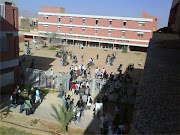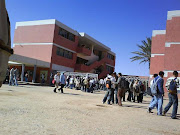Thursday, July 16, 2009
Sunday, May 10, 2009
Sunday, February 15, 2009
Friday, December 19, 2008

Globalization is a process of interaction and integration among the people, companies, and governments of different nations, a process driven by international trade and investment and aided by information technology. This process has effects on the environment, on culture, on political systems, on economic development and prosperity, and on human physical well-being in societies around the world.
Globalization is not new, though. For thousands of years, people—and, later, corporations—have been buying from and selling to each other in lands at great distances, such as through the famed Silk Road across Central Asia that connected China and Europe during the Middle Ages. Likewise, for centuries, people and corporations have invested in enterprises in other countries. In fact, many of the features of the current wave of globalization are similar to those prevailing before the outbreak of the First World War in 1914.................
click here to read more
Thursday, December 18, 2008
Refugees ( For my university students )
Who are refugees?
A refugee is a person who, "owing to a well-founded fear of being persecuted for reasons of race, religion, nationality, membership of a particular social group, or political opinion, is outside the country of his nationality, and is unable to, or owing to such fear is unwilling to, avail himself of the protection of that country..." (The United Nations Convention Relating to the Status of Refugees, 1951).
Imagine being so scared of being killed, tortured or victimised that you would leave your home, all your possessions and connections with your community, for an uncertain future. Fear drives people to leave with only a few belongings on a journey which is full of uncertainty. Will it be safe? Will they be able to return? In 2004 there were over 17 million refugees and 22 million internally displaced people who had taken that risk.
Who are 'people of concern'?
'People of concern' is a generic term used to describe all people for whom the United Nations High Commissioner for Refugees (UNHCR) is internationally responsible. They include:
• Refugees - people who are recognised as fleeing from persecution and who have left their own country. They come under international protection
• Asylum seekers - people who have fled their own country, and are seeking recognition by another country as a refugee and acceptance for resettlement. They are dependent on the good will and generosity of the country to which they have fled.
• Returned refugees - the unstable situations which have caused people to flee take time to settle, so the UNHCR monitors their situation for 12 months after they return home.
• Internally Displaced People (IDP) - some people who flee their homes in fear, but do not cross over their country's international borders come under UNHCR protection after the invitation by the government of their own country.
The increasing numbers of IDPs and awareness for the need for international protection has led to the development of the Guiding Principles on Internal Displacement.
• Stateless person - someone who is not considered a national by any country.
How are the rights of refugees protected?
The United Nations Convention Relating to the Status of Refugees (1951) and its 1967 Protocol outline the rights and processes protecting the needs of those who are recognised as refugees. A total of 147countries have committed themselves to upholding the provisions of one or both of these documents.
Most people fleeing their country conflict and persecution seek asylum in their nearest neighbouring country. Often these countries need support to provide for the sudden arrival of large numbers of uprooted persons. The Office of the United Nations High Commissioner for Refugees (UNHCR) co-ordinates contributions by government and non-government organisations to protect refugees, provides assistance such as financial grants, food, tools and shelter, schools and clinics, and attempts to find durable solutions to a given refugee crisis.
How are the rights of IDPs protected?
Concern for the increasing numbers of internally displaced people (IDPs) and questioning of the sovereignty of governments the UN Commission on Human Rights introduced the Guiding Principles on Internal Displacement in 1998. The Guiding Principles recognise the rights of internally displaced people and the obligations of governments and the international community toward these people.
In general the protection of IDPs is limited as governments of people affected may be either unable or unwilling to assist them. Security or political concerns and limited financial resources restrict the ability of international agencies and NGOs to offer assistance and provide protection.
Life in flight
Leaving home hurriedly, people often have few resources and are vulnerable to further attack. Sometimes they have many days of travel, with little food and in fear of their lives. If they get to safety, they rely on the people living in the area to which they have fled, who often have few resources to share. International organisations take time to mobilise the support necessary to provide refugees with adequate food, water and sanitation, shelter, healthcare, schools, trauma counselling and income generating activities so that they can regain some independence quickly. International organisations work together to provide these basic necessities.
When people arrive at an area which is set up as a temporary refugee shelter, they are registered for their protection and to their determine needs. Defining who and where people are assists in the supply of sufficient resources, especially for those with special needs such as separated children, those needing medical attention and the elderly.
Each situation is different. The length of time taken to resolve the conflict, resources available to meet needs, and the international ability to find solutions all impact on the ability of refugees to rebuild their lives.
How are refugee issues resolved?
Return home
The majority of refugees are able to return home after conflicts have ended, but a great deal of support is necessary to rebuild lives and infrastructure, and to restore stability. People who have been displaced need counselling, and practical assistance such as shelter, food and other items to restart their lives. People who have been involved in conflicts need alternative work. Homes, schools, health clinics, water and sanitation systems, and roads often need to be rebuilt. Landmines may need to be cleared. Trust between people who have been fighting needs to be re-established.
Resettlement in a new country
Some refugees cannot go home or are unwilling to do so, usually because they fear they would face continued persecution. In such circumstances, UNHCR helps to find them new homes, either in the country of asylum, or in a third country. This may take a long time, as there are more people in need than places available. Many nations accept refugees on a temporary basis during the early phases of a crisis but, are unable to provide long term support. Some more developed nations resettle refugees through a quota or a demand basis. Resettling refugees who have suffered a great loss, for example those who have suffered the destruction of their homes, families and sense of identity, requires tremendous support, as they usually have to learn a new culture and language, establish a new social network and earn a living.
Thursday, November 6, 2008
Learning Styles
This video is about learning styles and the different ways people learn.
Because people learn best in different ways, it is important when studying to
take into account your preferred way of learning. There have been several
models developed by psychologists to help us understand how we learn.
The one we will take about today is called the “VAK” model and divides all
people into three categories: visual learners, auditory learners and
kinesthetic learners.
Visual learners learn by seeing things. You can explain something to them
over and over but until they actually see it with their own eyes, they may not
get it.
Other people are much more able to remember and understand what they
hear. They may not understand something shown to them in pictures until
someone explains it to them. These people are called auditory learners.
They learn by hearing.
Finally, there are those who like the hands-on approach to learning. They
never really understand something until they get a chance to use it somehow.
They are kinesthetic learners. They learn by doing.
It is very helpful to know what your own preferred learning style is so that
you can personally tailor your study strategies with your learning style in
mind. This makes it an important tool in getting the most out of your study
time.
When you figure out what your own preferred learning style is, you can
implement specific study strategies to make your study time more effective.
For a visual learner, effective study strategies could include:
- drawing diagrams
- mind-mapping
- flashcards
- create a mental picture of the material using visual imagery
- rewriting professors notes in your own words
An auditory learner would find completely different strategies helpful, which
might include:
- taping lectures for review later
- having discussions with other students
- reading things out load (softly, to yourself)
- tutoring other students to reinforce knowledge
- participating in classroom discussions
For a kinesthetic learner, it is important to be involved in every step of the
learning process, and to have a chance to use concepts in a practical
environment. This might include:
- underline or highlight text with different colors
- reteach the topic to your group
- repeat answers while you are walking or jogging
- create practice tests for yourself
I would encourage all of you to take some of the many online quizzes that
help you determine your learning style. They don’t take much time to
complete and they could result in changing for the better the very way you
approach your education.
Sunday, November 2, 2008
Tuesday, October 28, 2008
Sunday, October 26, 2008
Wednesday, September 17, 2008
Friday, May 16, 2008
Friday, May 2, 2008
The other day as I was ricocheting slowly
Off the pale blue walls of this room,
Bouncing from typewriter to piano,
From bookshelf to an envelope lying on the floor,
I found myself in the L section of the dictionary
Where my eyes fell upon the word lanyard.

No cookie nibbled by a French novelist
Could send one more suddenly into the past --
A past where I sat at a workbench at a camp
By a deep Adirondack lake
Learning how to braid thin plastic strips
Into a lanyard, a gift for my mother.
I had never seen anyone use a lanyard
Or wear one, if that’s what you did with them,
But that did not keep me from crossing
Strand over strand again and again
Until I had made a boxy
Red and white lanyard for my mother.
She gave me life and milk from her breasts,
And I gave her a lanyard.
She nursed me in many a sickroom,
Lifted teaspoons of medicine to my lips,
Set cold face-cloths on my forehead,
And then led me out into the airy light
And taught me to walk and swim,
And I, in turn, presented her with a lanyard.
Here are thousands of meals, she said,
And here is clothing and a good education.
And here is your lanyard, I replied,
Which I made with a little help from a counselor.
Here is a breathing body and a beating heart,
Strong legs, bones and teeth,
And two clear eyes to read the world, she whispered,
And here, I said, is the lanyard I made at camp.
And here, I wish to say to her now,
Is a smaller gift--not the archaic truth
That you can never repay your mother,
But the rueful admission that when she took
The two-tone lanyard from my hands,
I was as sure as a boy could be
That this useless, worthless thing I wove
Out of boredom would be enough to make us even.
Sunday, April 27, 2008
Sunday, April 20, 2008
Thursday, April 17, 2008
Present wishes
I wish that I had a sports car.
I wish that I were a doctor.
(The truth is I don't have a sports car.)
(I'm really not a doctor.)
For present wishes, the past tense is used in the that clause, because it indicates a situation that is only imagined. Sometimes the word that is omitted.
She wishes (that) she had a diamond ring.
He wishes (that) he were rich.
To express possibility (can) and future intention (will), use the modals could and would respectively.
She wishes that she could sing.
They wish that she would stop.
When a be verb is required, the word were is used, regardless of the subject.
We wish you were here.
I wish (that) I were taller.
CLICK HERE FOR AUDIO

.jpg)
.jpg)

.jpg)
.jpg)






